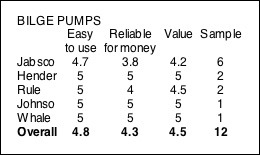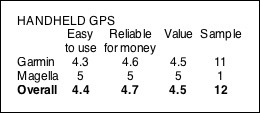Extra gear tested by the fleet of the Blue Water Rally 2007-09
Extra gear tested by the Blue Water Rally fleet 2007-09 which follows on from the feature in the December 09 issue of Yachting Monthly
ANTIFOUL

Some products performed well. Coppercoat, AF3000 Altex and Seahawk 44 both received full marks across the board, and Seajet Platinum 039 was described as ‘Excellent when we lifted after 15 months’ (Kaimin). ‘We don’t have to antifoul,’ said one skipper of his Cuprotect. ‘We had it done in 2004 and it’s still good except on the cast iron keel’ (Tapestry). Many used local products in the Caribbean and Fiji and some just accepted that nothing was going to work and sought out the cheapest product wherever they decided to reapply. Many were unimpressed. One aluminium-hulled yacht used International Trilux and commented ‘Very expensive and not very effective’ (Shaula III) and with International Micron Extra, the ‘Bottom starts to foul up after six months’ (Pelle V). International Micron was described as ‘No good for the tropics’ (Stargazer) and was replaced by AF3000 Altex in Australia, which performed very well. Clipper was said to have ‘Fair performance, lasted to Fiji, where we used a local brand, but needed much scrubbing and couldn’t cope with goose barnacles in the Atlantic’ (Rascal). In ‘Testing conditions’ Jotun’s Ablative Aluminium ‘Only just made 12 months’ (Evelyn) and Coppershield was ‘Totally useless for the tropical climate, we wasted a lot of valuable time cleaning the hull’ (Penelope III).
MAIN ENGINE

Main engines scored well with Yanmar topping the table and Perkins scoring top marks. Yanmar comments included ‘Fantastic reliability, quiet, over 2,800 hours so far without missing a beat’ (Rascal/Yanmar 4JH4E 54hp) One Volvo Penta owner thought his 2040 was ‘Fairly easy to service, a few problems with the cooling system’ (Stargazer/Volvo Penta 2040 40hp) while another 2040, despite professional maintenance and only 2,040 hours logged, had to be replaced with a Yanmar after extensive problems ‘An expensive and time consuming business’ (Tapestry/Volvo Penta 2040 40hp). While engines scored well, there were some frustrations: ‘No problems with the engine but some with the fuel circuit’ (Shaula III/Volvo Penta MD-22 50hp), and ‘The engine is good, the problem is the auxiliaries – alternator, heat exchanger – all because of age’ (Cayuco/Perkins 72hp). Cayuco was the oldest yacht in the rally, a Salar 40 built in 1971. Other comments related to the location of impellers and other elements requiring maintenance: ‘Servicing would be much easier with more thought during design’ (Lady In White/Perkins M90).
STEERING

There was a variety of systems in use, including direct link and chain and cable. Like main engines, there seem to be few problems with steering systems but two skipper remarked that there had been ‘a few problems with dry cables, they need lubricating’ (Tapestry)
FRIDGES

As the fleet spent a lot of time in the tropics and away from sources of fresh victuals, refrigeration was an important factor and generally, the kit was up to the task. Frigoboat fridges attracted high marks and comments such as ‘Excellent, worked all the time without any problem’ (Fine Fleur). One skipper, who has had a Frigoboat fridge for 20 years, said ‘Problems with relays but otherwise excellent’ (Carelbi) and the same skipper noted that ‘Most new yachts don’t have enough insulation.’ Another said that his Frigoboat fridge ‘worked well, though the lids are prone to collapse on you’ but that his freezer ‘Frequently iced up due to a poor fitting lid’ (Baccus). Isotherm also attracted high scores and comments like ‘Excellent’ (Stargazer), ‘No issues’ (Pelle V) and ‘Totally reliable and extremely low power consumption but top-opening in main worktop area is not very convenient’ (Rascal). The only negative for Isotherm’s ASU watercooled unit was ‘Under-dimensioned control unit failed four times’ (Shaula III). It was also noted that ‘The ice machine from Raritan is lovely to have in the tropics’ (Pelle V).
WATERMAKERS

Most of the fleet had watermakers. The skipper of one of the yachts that didn’t said ‘A proper, installed watermaker would have been very useful, especially between the Galapagos and Tahiti where the only potable water available was in bottles’ (Rascal). Generally they performed well, as the scores reflect. The Katadyn 160E was ‘Excellent’ (Stargazer), as was the Spectra Cape Horn, which ‘Worked all the time without any problem, produced 70 litres an hour and low amp consumption’ (Fine Fleur). One skipper said of his Seafresh 220VAC unit that he was ‘Very happy with its 60 litres per hour’ but that he ‘Needs to run the generator, so I would choose 12VDC in future’ (Carelbi). Another said of his Dessalator D60 that it ‘Worked well with regular maintenance – take several spare filters’ (Baccus) while another with the same unit said ‘This unit was the most trouble. The auto water quality control board was changed twice and the pulleys were changed then welded by us’ (Jenny). One point made by many skippers was that ‘It requires that the generator is running. It would be nice if it could also run with power from the main engine’ (Pelle V). Genset reliability was an issue for much of the fleet, which jeopardises the water production of AC watermakers. There are high yield watermakers than run from a high pressure pump, belt-driven off the engine, and there are also lower yield watermakers that can be run using 12VDC.
WATER PUMPS

Overall, water pumps performed satisfactorily, though there were some complaints. Flojet’s Quad II diaphragm pump is ‘Very reliable, no failures’ (Lady In White). Jabsco’s Par Max III and IV pumps scored very highly except for this comment: ‘Installs very easily. We are on our third pump because the switches keep burning out – very unsatisfactory’ (Penelope III).
BILGE PUMPS

Again, value for money scores are very high and there are very few comments made beyond the occasional ‘No problems’ (Miss Styx) about her Jabsco pumps. It seems the manual pumps performed faultlessly, or were never called into action. Automatic pumps also scored highly but there were problems. ‘Plastic cases on the Rule pumps are not robust enough, they have collapsed where the hoses attach twice’ (Evelyn) and ‘Jabsco model 34600 is very unreliable, we’ve had many failures’ (Lady In White). The most telling quote was from the only yacht that badly needed a good bilge pump, when they were knocked down off Panama. ‘Jabsco membrane pumps aren’t suitable for the job, they’re too slow – the yard’s choice’ (Shaula III).
BATTERY CHARGERS

Although most yachts were fitted with battery chargers, and many were reliable, lower value for money scores reflect the fact that they weren’t often used because of the lack of shore power in many destinations. Cristec scored very well, and their 25A unit was ‘OK, no problems but seldom used – no shore power’ (Shaula III). Mastervolt scored well generally but their average was lowered by comments like ‘Mastervolt 60A redundant and no longer supported despite being only four years old’ (Tapestry). The unit was replaced with a Mastervolt 60A/1200W inverter however. Another skipper needed a new fridge compressor and it required a clean sine wave so he spent £4,000 on a new Mastervolt charger-inverter and scored it highly but did comment ‘You can’t turn off the charging but it does present a second way of running the fridge and watermaker’ (Carelbi). Victron scored well, as did Mobitronic with comments like ‘Superb, easy to install’ (Rascal) and Sterling, with one skipper saying ‘Our Sterling 24V/25A was no problem at all, absolutely reliable, even charges through the generator if necessary’ (Cayuco). Tescup faired less well, with one skipper remarking ‘The Tescup Hi Tec 12V/60A suffered total failure after four years in high ambient temperatures and the Hi Tec 24V/50A cooling fans failed after two years’ (Lady In White)
GPS ANTENNA

GPS scores across the board were high, suggesting the industry has undoubtedly cracked GPS reception. Very few remarks were made about this piece of ‘fit and forget’ equipment.
HANDHELD GPS

Many boats carried handheld GPS units as back-up for the main GPS but, as we’ve seen, the reliability of the yacht’s man GPS antenna was high enough for them hardly ever to be needed.
LONG RANGE COMMS: SSB

Most of the fleet chose the Icom M801 or 802. The ease of use scores reflect the difficulty some experienced using SSB but it could also reflect the fact that, while the unit might work with faultless reliability, propagation of SSB signals isn’t always reliable. ‘Good but expensive. Takes a while to get used to but quite satisfying to use and good enough data speeds most of the time. Didn’t miss a satphone’ (Rascal) said one skipper of his Icom M801 and Pactor modem, required to use SSB for email. ‘Excellent but overcomplicated’ (Stargazer) said another. ‘Excellent, except for installation’ (Baccus) said a third, reflecting how reliant SSB is on being installed correctly.
LONG RANGE COMMS: SATCOMS

Most yachts also chose satellite communications and the great majority chose Iridium for its ease of use and superior coverage, and rated it highly. Comments included ‘Easy interface with computer, good last resort with communications to anywhere. Expensive call charges but it enables access to essentials like GRIB weather files’ (Evelyn). ‘Good performance’ (Shaula III) said one skipper, ‘Very pleased’ (Carelbi) said another.




